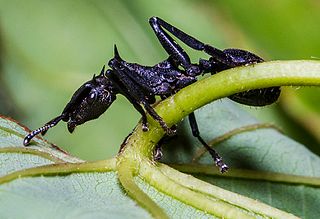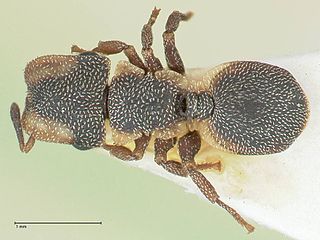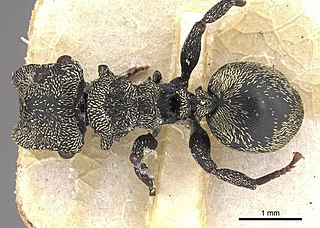
Cephalotes is a genus of tree-dwelling ant species from the Americas, commonly known as turtle ants. All appear to be gliding ants, with the ability to "parachute" and steer their fall so as to land back on the tree trunk rather than fall to the ground, which is often flooded.

Cephalotes atratus is a species of arboreal ant in the genus Cephalotes, a genus characterized by its odd shaped head. These ants are known as gliding ants because of their ability to "parachute" by steering their fall if they lose their footing.

Cephalotes depressus is a species of arboreal ant of the genus Cephalotes, characterized by an odd shaped head and the ability to "parachute" by steering their fall if they drop off of the tree they're on. Giving their name also as gliding ants.

Cephalotes jansei is an extinct species of arboreal ant of the genus Cephalotes, originally erroneously called Exocryptocerus jansei by its discoverers, characterized by an odd shaped head and the ability to "parachute" by steering their fall if they drop from a tree, giving them the nickname of gliding ants. The species was probably native of Hispaniola, however, lack of more evidence makes this uncertain. Their larger and flatter legs, a trait common with other members of the genus Cephalotes, gave them their gliding abilities.

Cephalotes jheringi is a species of arboreal ant of the genus Cephalotes, characterized by an odd shaped head and the ability to "parachute" by steering their fall if they drop off of the tree they're on. Giving their name also as gliding ants.
Cephalotes liepini is a species of arboreal ant of the genus Cephalotes, characterized by an odd shaped head and the ability to "parachute" by steering their fall if they drop off of the tree they're on. Giving their name also as gliding ants. The species is native of the Brazilian states of Goiás and Minas Gerais. Their larger and flatter legs, a trait common with other members of the genus Cephalotes, gives them their gliding abilities.
Cephalotes maya is an extinct species of arboreal ant of the genus Cephalotes, characterized by an odd shaped head and the ability to "parachute" by steering their fall if they drop off of the tree they're on. Giving their name also as gliding ants. The species was probably native of the Mexican state of Chiapas, however, lack of more evidence makes this uncertain. Their larger and flatter legs, a trait common with other members of the genus Cephalotes, gave them their gliding abilities.
Cephalotes nilpiei is a species of arboreal ant of the genus Cephalotes, characterized by an odd shaped head and the ability to "parachute" by steering their fall if they drop off of the tree they're on. Giving their name also as gliding ants. The species is native of the Brazilian states of Minas Gerais and Rio de Janeiro. Their larger and flatter legs, a trait common with other members of the genus Cephalotes, gives them their gliding abilities and eases their arboreal movement.

Cephalotes pallidoides is a species of arboreal ant of the genus Cephalotes, characterized by an odd shaped head and the ability to "parachute" by steering their fall if they drop off of the tree they're on. Giving their name also as gliding ants.
Cephalotes peruviensis is a species of arboreal ant of the genus Cephalotes, characterized by an odd shaped head and the ability to "parachute" by steering their fall if they drop off of the tree they're on. Giving their name also as gliding ants. They can be found in Peru, Costa Rica, and the Osa Peninsula.

Cephalotes pinelii is a species of arboreal ant of the genus Cephalotes, characterized by an odd shaped head and the ability to "parachute" by steering their fall if they drop off of the tree they're on. Giving their name also as gliding ants.
Cephalotes setulifer is a species of arboreal ant of the genus Cephalotes, characterized by an odd shaped head and the ability to "parachute" by steering their fall if they drop off of the tree they're on. Giving their name also as gliding ants.
Cephalotes spinosus is a species of arboreal ant of the genus Cephalotes, characterized by an odd shaped head and the ability to "parachute" by steering their fall if they drop off of the tree they're on. Giving their name also as gliding ants.

Cephalotes targionii is a species of arboreal ant of the genus Cephalotes, characterized by an odd shaped head and the ability to "parachute" by steering their fall if they drop off of the tree they're on. Giving their name also as gliding ants.
Cephalotes ventriosus is a species of arboreal ant of the genus Cephalotes, characterized by an odd shaped head and the ability to "parachute" by steering their fall if they drop off of the tree they're on. Giving their name also as gliding ants.

Cephalotes clypeatus is a species of arboreal ant of the genus Cephalotes, characterized by an odd shaped head and the ability to "parachute" by steering their fall if they drop off of the tree they're on. Giving their name also as gliding ants.

Cephalotes emeryi is a species of arboreal ant of the genus Cephalotes, characterized by an odd shaped head and the ability to "parachute" by steering their fall if they drop off of the tree they're on. Giving their name also as gliding ants.
Cephalotes frigidus is a species of arboreal ant of the genus Cephalotes. They are characterized by an odd shaped head and the ability to "parachute" by steering their fall if they drop off of the tree they are on. As a result, they are also called gliding ants.
Cephalotes persimplex is a species of arboreal ant of the genus Cephalotes, characterized by an odd shaped head, and the ability to "parachute" by steering their fall if they drop off of the tree they're on. Giving their name also as gliding ants.

Cephalotes quadratus is a species of arboreal ant of the genus Cephalotes, characterized by an odd shaped head, and the ability to "parachute" by steering their fall if they drop off of the tree they're on. Giving their name also as gliding ants.










